Day 3 of our big 5 day Spring Bird Tour. The weather is finally improving – although it was cloudy and cool this morning, it was dry all day. By the afternoon we even had some blue sky and sunshine – it even felt like spring!
As we drove west, we decided to have another quick look at Choseley on the way, on the off chance that the Whinchats seen there yesterday were still present. We were just driving up past the drying barns when we spotted a plump bird land on the wires as we passed. A quick stop and we could just see it was a Corn Bunting, but it flew down before anyone could get onto it. We parked the car and got out to see if we could find it again. A Brown Hare was in the field next to us but ran off as we all emerged.
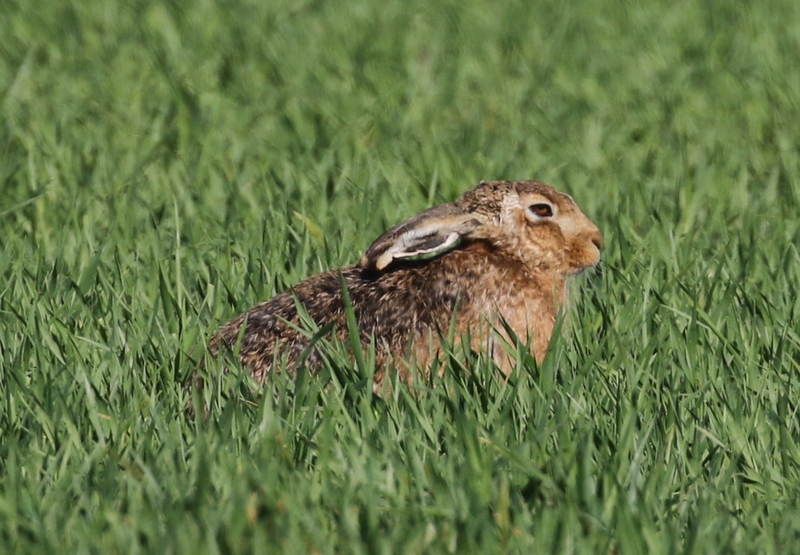 Brown Hare – in the field next to where we parked
Brown Hare – in the field next to where we parked
The first birds we saw were two Turtle Doves which flew in and landed on the wires. They also dropped down into the field nearby out of view, so we carefully looked round the corner of the hedge. Unfortunately, the Corn Bunting had now disappeared, but the edge of the field was alive with birds. As well as the Turtle Doves, there were quite a few Yellowhammers and a couple of Red-legged Partridge. We stopped to watch them for a while.
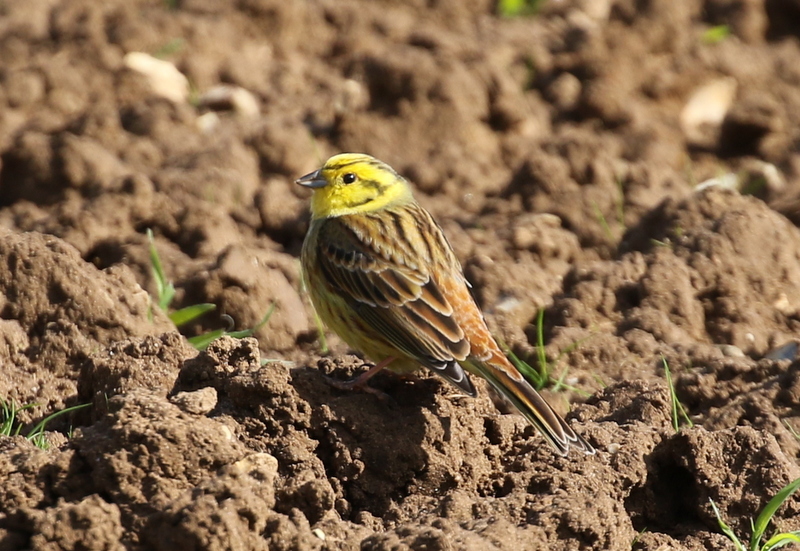 Yellowhammer – there were lots at Choseley today, including several bright males
Yellowhammer – there were lots at Choseley today, including several bright males
The Turtle Doves flew out further into the field when they saw us, but then flew round and landed on the concrete pad nearby. Most of the Yellowhammers flew over too – at one point we counted 11 Yellowhammers all together. They were all picking around on the concrete looking for any spilled grain. Several Pied Wagtails were feeding in the short grass along the footpath beyond.
 Turtle Dove – a pair were around the Drying Barns this morning
Turtle Dove – a pair were around the Drying Barns this morning
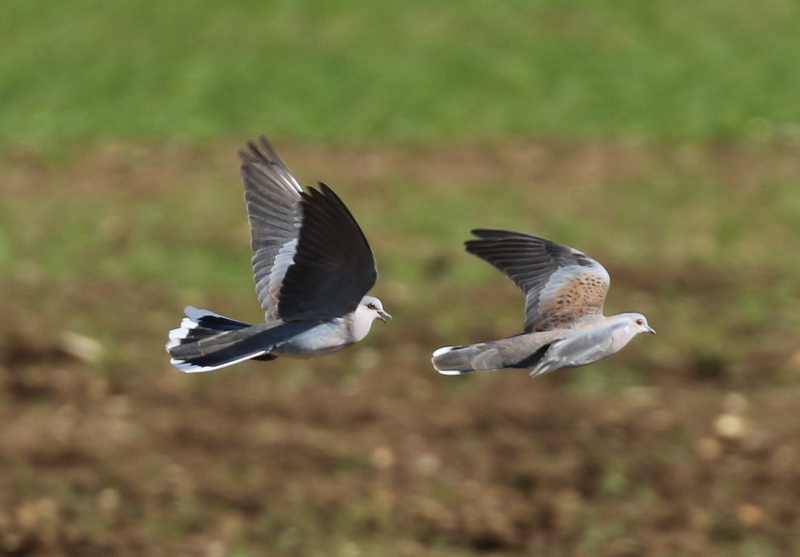 Turtle Doves – the female was trying to evade the advances of the male
Turtle Doves – the female was trying to evade the advances of the male
The birds continued to commute back and forth between the pad and the field. The male Turtle Dove started displaying to the female, chasing after her and bowing. She didn’t seem particularly interested and kept running away, and when he got too persistent she flew up with him still in pursuit. Two Common Whitethroats were singing from hedges and a few Swallows zipped through, but there was still no further sign of the Corn Bunting so we decided to try our luck down on the corner at the bottom of the hill.
When we got there, we could see the Wheatears were still out in the same field they were in yesterday, but we couldn’t find any sign of the Whinchat here today. We were hoping we might hear a Corn Bunting singing here, but it was all quiet. We did see a Corn Bunting fly over though, which disappeared off across the field towards the Thornham road. The surrounding fields were full of Brown Hares. We did get a bit of chasing today, but they quickly lost interest and didn’t start boxing.
Our next destination for the morning was Snettisham Coastal Park. When we arrived, we decided to have a quick look at the Wash, but the tide was still in and there was no sign of any mud emerging yet. We could hear Willow Warblers singing from the bushes and a Lesser Whitethroat rattling too. As we walked round to the main path, we could hear Blackcap and Song Thrush singing too, but by the time we got to the other side the Lesser Whitethroat had gone quiet.
As we walked north through the bushes, the place was alive with birdsong. There were loads of Sedge Warblers, sitting in the tops of the bushes or songflighting, fluttering up and parachuting back down.
 Sedge Warbler – there were lots singing from the bushes today
Sedge Warbler – there were lots singing from the bushes today
This is a great place to see Common Whitethroats. They too were singing from the bushes all the way up and display flighting. There are fewer Chiffchaffs here, but still we heard a couple. We had hoped to catch up with Grasshopper Warbler here today, but they were rather quiet as we walked up, with just a quick bout of reeling heard from some distance away. A Cuckoo accompanied us, singing all the way up, though keeping out of sight the other side of the bushes.
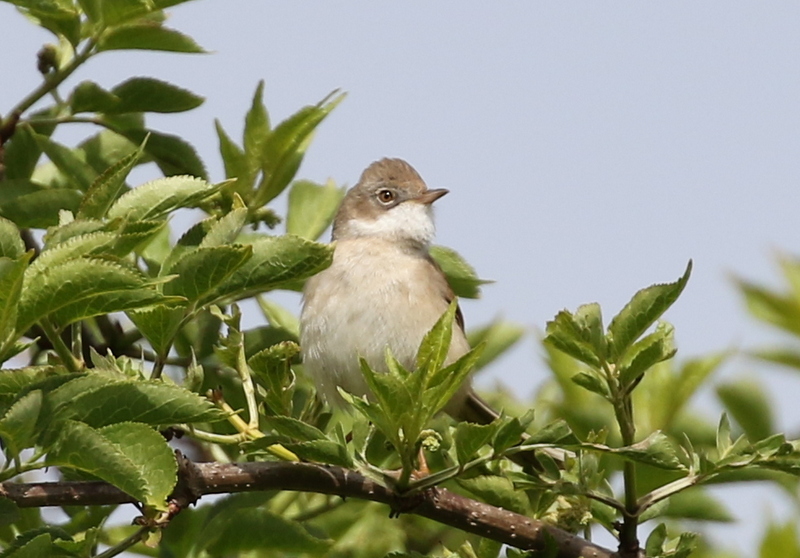 Common Whitethroat – they were singing everywhere today
Common Whitethroat – they were singing everywhere today
We had thought we might see some visible migration here today, with the weather gradually improving. Unfortunately, with the wind still in the northwest there were just a few hirundines on the move, lone birds or little groups of Swallows and a handful of House Martins with them. Otherwise, there were a few Linnets and Goldfinches in the bushes and a male Stonechat in the brambles by the seawall.
When we got to the cross-bank, we had another look out to the Wash. It was a very big tide again today, and it was only just starting to go out far enough to expose some mud. The Oystercatchers which had been roosting on the beach further up were starting to feed along the shoreline and in between them we could see several tiny Sanderlings running along the water’s edge. There was a Turnstone here too and a couple of Ringed Plovers which made themselves difficult to see, running up the beach and then standing stock still camouflaged against the stones.
Over the other side of the seawall, on the short grass north of the cross-bank, we found a few Black-tailed Godwits including one in bright orange summer plumage. A Whimbrel was hiding down in the grass too. A pair of white-winged adult Mediterranean Gulls flew over our heads calling.
From over on the inner seawall, we stopped to scan over Ken Hill Marshes. There are always lots of geese here, Greylags, Canada and Egyptian Geese in particular. In addition, there is still a lingering group of Pink-footed Geese, at least 60 here today. We got them in the scope, noting their smaller size and darker heads compared to the Greylags, as well as their more delicate pink-banded mostly dark bills. Most of the Pink-footed Geese have already left, so they should be on their way back to Iceland soon, and there were also a few Wigeon still around the pools here, which should be heading back to Russia for the breeding season.
There were a couple of Reed Warblers singing from deep in the reeds here, but we still couldn’t hear any Grasshopper Warblers. We walked down and through the brambles where a couple of males have been holding territory recently, but they were both quiet. Eventually we heard a snatch of song and managed to find one of the males, but we only saw him zipping across between bushes and heard the odd call too. We really wanted to find a Grasshopper Warbler perched up and in full voice.
As we walked back to the inner seawall, we caught the briefest of glimpses of a blackbird-sized bird as it disappeared round behind a bush. It seemed slimmer than a Blackbird though, with longer tail and wings – it had to be a Ring Ouzel. Unfortunately, when we got round to the other side of the bush, it had completely disappeared.
There happened to be another birding group coming towards us along the inner seawall, and they asked if we had just seen a Ring Ouzel. They too had just had a glimpse of something which they thought might be one as it zipped over the bank and it had gone down into a hawthorn bush by the reeds the other side. As we walked along to where it had gone, we had a quick glimpse of it as it flicked between bushes.
When it finally came out properly it was off, flying strongly inland and out of sight, at which point our suspicions were confirmed, it was a female Ring Ouzel. Not the best of views, but a nice bird to find here. A loose spaniel was running amok out on the grazing marshes at this stage and managed to flush out three Whimbrel and a pair of Grey Partridge for us. We had a good look at the Whimbrel through the scope.
As we carried on south along the seawall, a Grasshopper Warbler suddenly burst into song, from the brambles just below the bank. Just like buses, a second Grasshopper Warbler then started up just a short distance away. We managed to find the first and got the scope on it, watching it reeling away, sounding rather like a grasshopper. It moved around a few times, reeling all the time, before finally dropping down into the grass out of sight. It was worth the wait to get such good views.
 Grasshopper Warbler – one of two reeling from the brambles by the inner seawall
Grasshopper Warbler – one of two reeling from the brambles by the inner seawall
As we made our way back to the car along the inner seawall, a small mammal ran out of the taller grass and onto the path. It was small, slim and a distinctive gingery colour – a Harvest Mouse. With all of us walking along, it couldn’t work out how to get to the other side and ended up running over my shoe! We also got distant views of a male Wheatear up on the far seawall and then much closer views of a female down on the short grass in the clearing by the car park.
From up on the outer seawall, the tide was now well out and there was lots of exposed mud. It was covered in thousands of waders – mostly Knot, but we could also see Bar-tailed Godwits, Grey Plovers and Dunlin. Something spooked them and we had a quick fly round at one point, allowing us to appreciate just how many there were.
 Knot – still large numbers out on the Wash at the moment
Knot – still large numbers out on the Wash at the moment
After lunch back at the car, we made our way round to Dersingham Bog. Once we got out of the trees, the first birds we found were a pair of Stonechat. There were lots of Linnets everywhere, on the path, perched in the trees or flying round. A large bird appeared high over the bog behind us, flying with stiff wing beats. It was a Short-eared Owl. It flew very purposefully up towards the trees and disappeared from view.
That was a most unexpected bonus, but imagine our surprise when a second Short-eared Owl flew up from the bog only a minute later. This one circled up over the boardwalk in front of us for a couple of minutes before also disappearing inland.
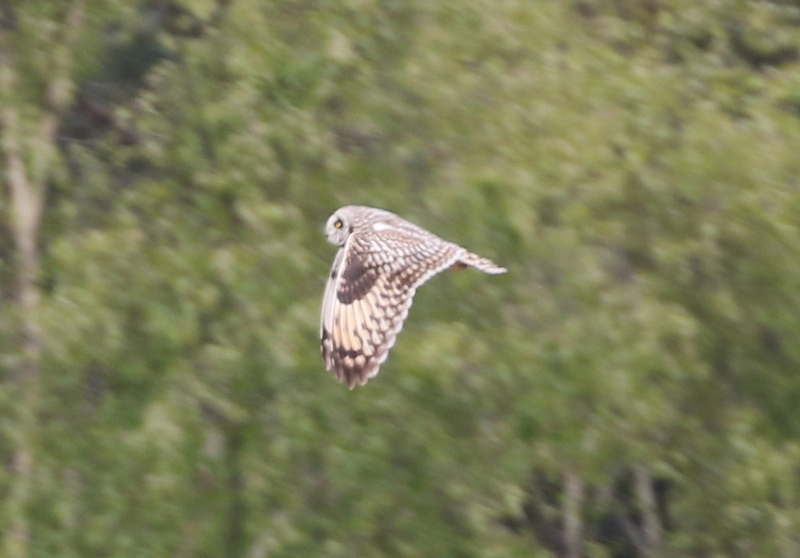 Short-eared Owl – the second we saw fly up from the Bog today
Short-eared Owl – the second we saw fly up from the Bog today
What we had really hoped to see here was a Tree Pipit, but we couldn’t hear one singing at first. We walked back along the path to some trees where they can often be found, and after scanning carefully found one perched high in a tall oak tree. We had a good look at it in the scope and it did break into song briefly, but was not going to display for us. When it took off, we watched it fly back and chase a second Tree Pipit which was displaying further behind, before returning to its tree. When the Tree Pipit disappeared again, we made our way back to the car park.
A quick diversion on the way back to the north coast and we arrived by the cliffs at Hunstanton. We wanted to see a Fulmar and before we even got out of the car, we spotted one gliding effortlessly along the clifftops. We stood on the grass for a while and watched several Fulmars flying up and down. One flew higher up and overhead too, while another took a detour over the houses the other side of the road. A quick look out to the Wash below produced a single, very distant Great Crested Grebe.
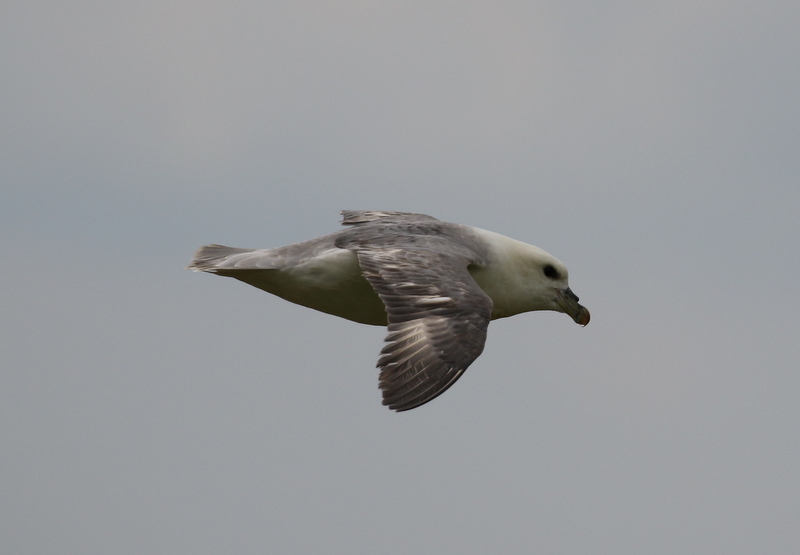 Fulmar – gliding along the cliffs at Hunstanton
Fulmar – gliding along the cliffs at Hunstanton
We finished the day with a quick walk through the dunes at Holme. As we walked along the boardwalk, a deep rusty orange summer plumage Bar-tailed Godwit flew across the saltmarsh and landed on the mud. There were several Common Whitethroats singing from the bushes in the dunes and we finally got a better view of a Lesser Whitethroat here too. There were loads of Linnets feeding in the short grass and a very smart male Wheatear as well, which we had to stop and admire through the scope.
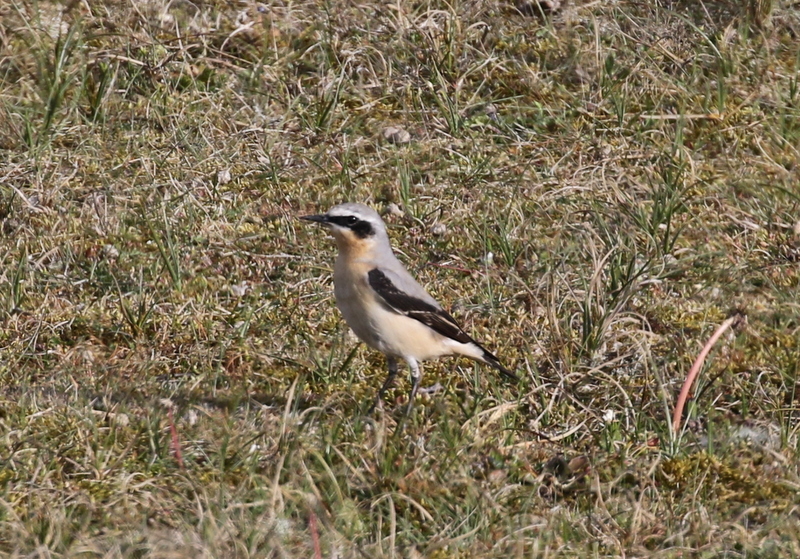 Wheatear – a smart male, feeding in the dunes at Holme
Wheatear – a smart male, feeding in the dunes at Holme
It had been enough of a surprise to see one Short-eared Owl at Dersingham earlier, let alone two. Then here at Holme we came across our third Short-eared Owl of the day! This one was quartering an area of dunes. We watched as it flew back and forth for a couple of minutes, before it dropped down into the grass.
What we had really hoped to see here was a Ring Ouzel and one duly obliged by flying past us. It was a marginally better view than we had enjoyed earlier at Snettisham. We walked over towards where it seemed to have landed, guided by another couple who had seen it fly across too. As we approached, we could hear chacking calls and suddenly a Ring Ouzel flew out of the bushes. It was promptly followed by a second, then a third, and the next thing we knew we had six Ring Ouzels in the air together. They circled round a couple of times over the bushes, giving us a great look at them, before flying right over our heads and back across the dunes.
 Ring Ouzel – six flew out of the bushes and over our heads
Ring Ouzel – six flew out of the bushes and over our heads
We had to go back that way, and just along the path we found the other couple of birders watching the Ring Ouzels in the dunes. From a discrete distance, we watched as they flew down from the bushes and hopped around on a sandy bank, a couple of smart males with bright white gorgets and a couple of females with duller buff-brown crescents on their breasts. It was great to get such a good look at these generally very flighty birds.
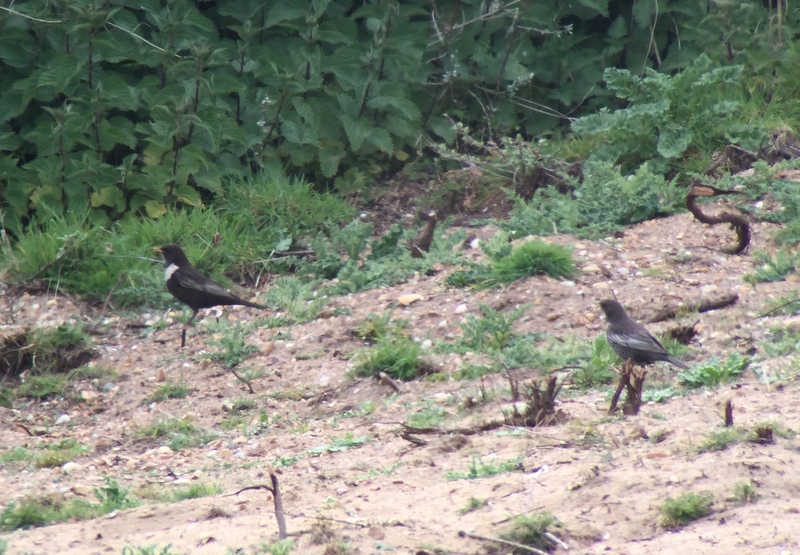 Ring Ouzel – we eventually got great views of them feeding on a sandy bank
Ring Ouzel – we eventually got great views of them feeding on a sandy bank
That was a great way to round off the day, so we headed back to the car well pleased. One more final bonus was in store though – as we drove back out along the entrance track a ghostly white Barn Owl appeared and circled over the bushes a couple of times before dropping down towards the paddocks out of view. It had really been quite an owl afternoon!
















